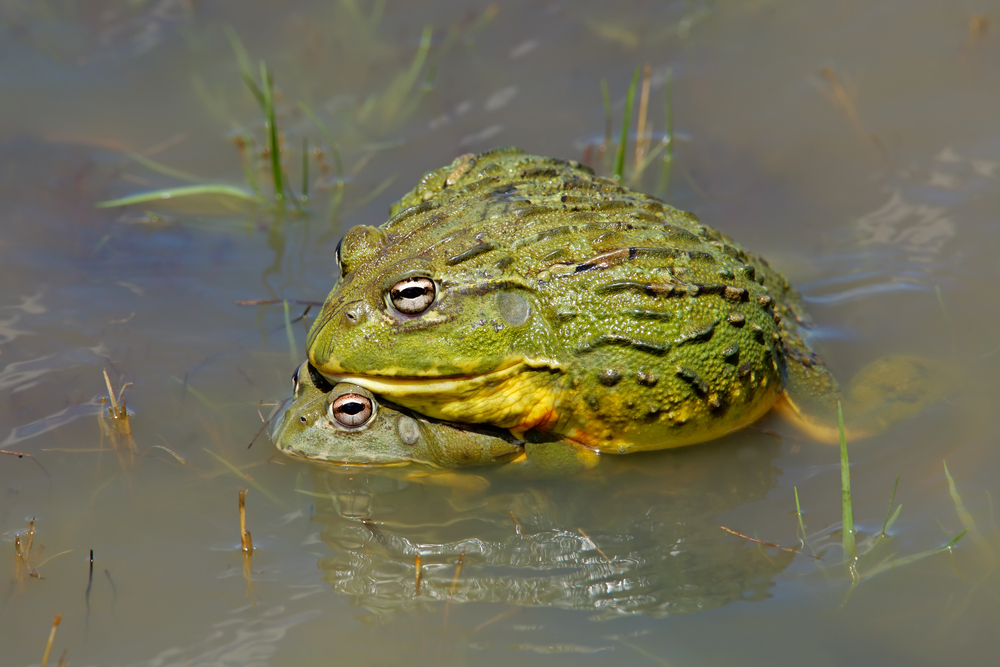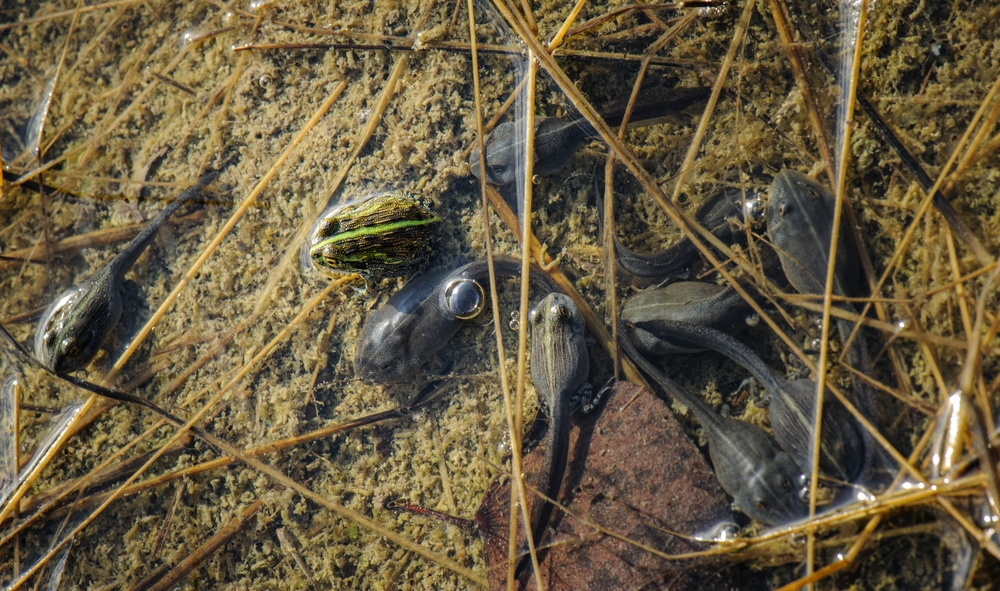Huge, lime-green frogs, bouncing around the interior of sub-Saharan Africa are a spectacle for any wildlife filmmaker making the African bullfrog (Pyxicephalus adspersus) a well-known amphibian across the world. It is a ravenous predator, devoted parent and miraculous survivor in harsh conditions. For a long time “pyxies” (a colloquial term named after the bullfrog’s scientific name) and “pacmans” were grouped in terms of husbandry, however, there are some stark differences in the natural history of these two very distant groups of amphibians.
Natural History of the African Bullfrog
The African bullfrog (Pyxicephalus adspersus) is one of the largest frogs on Earth. Weighing up to 1.5kg and measuring up to 30cm, these bulky frogs are remarkable. Unusually for frogs, the females are much smaller than the males and will grow to about half the size of an adult male. This may help with amplexus by allowing the dumpy and clumsy frogs to grip onto a female much easier during breeding.
Both sexes have ravenous appetites and will feed on almost anything they can fit in their mouth. They can do this due to their two large “fangs” on their bottom jaw which protrude upwards like teeth and help grip and hold prey items before the frog consumes them. They are one of few amphibians capable of delivering a painful bite.
From termites to small mammals, the frogs will overpower just about anything they can. One case study even recorded a giant bullfrog eating 17 highly venomous juvenile Rinkhals (an African elapid that resembles a cobra), possibly in a single sitting, without facing any adverse effects.
African bullfrogs have a beastly reputation and some otherworldly adaptations to surviving in harsh environments. Like many arid frogs, they can develop a thick layer of mucous to combat water loss during estivation. During dry periods, they will dig burrows into the soil and form a protective layer which holds in moisture and remains dormant for months (sometimes years!) at a time.
Giant African bullfrogs are exceptionally long-lived frogs. Although a typical captive lifespan is 20 – 30 years, there have been reports of males living up to 50 years old. While this happens frequently in some lineages of salamander, it is unusual for frogs. With excellent care, the keeper should expect to have their animal for multiple decades and potentially generations.

Keeping African Bullfrogs
African bullfrogs require similar care to the Cranwell’s horned frog (C. cranwelli). In the wild, both species experience dry periods and live in savannah and woodlands, however, the African bullfrog experiences slightly cooler and drier conditions. Both species naturally aestivate, but the novice keeper should probably consider avoiding this process. Most keepers therefore recommend maintaining humidity above 70% and allowing constant access to water.
Giant African bullfrogs are possibly more active than horned frogs too, occasionally hunting for prey instead of waiting in ambush. African bullfrogs typically have one “home” burrow and will scavenge for food within 20m of their burrow. Therefore, African bullfrogs should be provided with a reasonably large terrarium to move around freely. A 90x45x45cm glass terrarium is suitable for a single adult male. Females and juveniles can be housed in something slightly smaller. Many hobbyists will opt for plastic tubs to house bullfrogs. These put practicality and affordability ahead of aesthetics but can certainly do the job.
African bullfrogs do not “sleep.” Whilst a captive frog may appear reasonably stationary throughout the day, it may be more active at night. Alternatively, unusually active frogs may just be switching their hunting behaviours and activity levels to suit the environmental conditions they are in. Because of this, it is important to create an enriched and varied enclosure. Today, most hobbyists opt for a paludarium setup for these frogs. Whilst seasonally appropriate enclosures may be more suitable, switching between a paludarium in summer and a terrarium in winter, a well-constructed paludarium can certainly meet the needs of a giant African bullfrog.

Bullfrog Enclosure Design
African bullfrogs can be housed in the simplest of enclosures, in a plastic tub with a freshwater bowl and plenty of substrate. However, it is far more enjoyable for keepers to create a visually interesting exhibit to experience a wide range of natural behaviours from the animal.
A 90x45x45 terrarium is perfect to build a 70/30 land-to-water paludarium setup. This enclosure will provide more reliable water quality, less need for spraying/misting, the opportunity to offer aquatic prey, safeguarding against aestivation/drying out and an excellent display.
The keeper should begin by dividing the enclosure with a glass panel and sealing it with aquarium-safe silicon. The larger land area should have a drainage layer (ProRep BioLife and Lucky Reptile Hydrodrain are our favourites) and be topped with some fine mesh and several inches (or as much as possible) of natural substrate such as BioLife Forest or EcoEarth and topped with sphagnum moss and leaf litter. This area will capture water, so the keeper should consider creating access for drainage. An acrylic tube leading to the base (but not touching the base) will allow the keeper to use a turkey baster or tubing to draw any excess water from the drainage layer easier than digging into the substrate to remove it.
The second area will be the aquatic section. This should operate like a shallow fish tank, a submersible water filter or ExoTerra “Turtle Filter” can be placed in the water. Water should then be directed back into the aquatic section (trickling over some cork bark or rock formation is an interesting way to do this). Pebbles and riverbed sand can then be used to bulk out the water area and provide access in and out of the water.
Top the enclosure off with a Zone 1 Eco-T5 from Reptile Systems and a strong LED grow light to add bright visible light and the enclosure is complete.
Captive Breeding of Pyxicephalus
African giant bullfrogs are philopatric in the wild, meaning they will return to a particular breeding site each year. Breeding is explosive and quick. It typically occurs after a dry period, when there is around 2 days of heavy rain resulting in at least 3 inches of water. The frogs will congregate in temporal pools and ditches, where competition is fierce. Dominant males will protect their territory in the centre of a breeding pool (and fight to the death to hold it), while less dominant males gather at the water’s edge. Males will also protect their offspring to give them the best chance of surviving the often-brief rainy seasons, even digging canals to provide access to fresh water.
Females will typically select the largest male in the centre of the pool to breed with. Amplexus happens quickly and lasts just 15 minutes. Next, up to 3,000 eggs are deposited in the shallow water. Less than 48 hours later, the tadpoles emerge and begin creating schools that, over time, merge into one huge mass of tadpoles.
The tadpoles can take two to four weeks to metamorphose into juvenile frogs. At this point, the young frogs leave the breeding pools to find burrows and humid areas to hunt from and avoid predation from larger frogs.
Whilst these behaviours are truly fascinating in the wild, they leave the breeder with thousands of juvenile frogs to feed. The process is quick, success rates are often very high and cannibalistic frogs must be separated quickly. This is partly why African bullfrogs are so affordable in the hobby. It is not advisable to begin breeding these frogs without a sincere commitment to a more commercial venture and obvious routes to new homes.



